
Concept explainers
Give the IUPAC name for each compounds.
a.  c.
c.  e.
e.  g.
g. 
b.  d.
d.  f.
f.  h.
h. 
(a)
Interpretation: The IUPAC name of the given compound is to be stated.
Concept introduction: IUPAC nomenclature is a systematic way of naming the organic compounds. The basic principles of IUPAC naming for benzene derivatives are:
1. The compound consists of benzene ring is named as substituent followed by benzene.
2. When the ring is mono-substituted, then there is no need of numbering.
3. When the ring is substituted with same substituents, then numbering to one substituent is given and for other substituent, numbering proceed from clockwise or anticlockwise such that it gets lower number.
4. When the ring is substituted with different substituents, then the numbering is done according to priority.
5. Substituents on benzene ring is also indicated using ortho, meta, para prefix. The prefix ortho is used when substituents are on adjacent carbon, meta is used when substituents are separated by one carbon atom, para is used when substituents are across each other in benzene ring.
Answer to Problem 17.28P
The IUPAC name of the given compound is
Explanation of Solution
The given compound is,
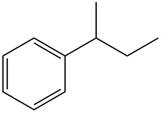
Figure 1
The parent ring is benzene. The substituent attached to the benzene ring is sec-butyl. Therefore, the IUPAC name of the given compound is
The IUPAC name of the given compound is
(b)
Interpretation: The IUPAC name of the given compound is to be stated.
Concept introduction: IUPAC nomenclature is a systematic way of naming the organic compounds. The basic principles of IUPAC naming for benzene derivatives are:
1. The compound consists of benzene ring is named as substituent followed by benzene.
2. When the ring is mono-substituted, then there is no need of numbering.
3. When the ring is substituted with same substituents, then numbering to one substituent is given and for other substituent, numbering proceed from clockwise or anticlockwise such that it gets lower number.
4. When the ring is substituted with different substituents, then the numbering is done according to priority.
5. Substituents on benzene ring is also indicated using ortho, meta, para prefix. The prefix ortho is used when substituents are on adjacent carbon, meta is used when substituents are separated by one carbon atom, para is used when substituents are across each other in benzene ring.
Answer to Problem 17.28P
The IUPAC name of the given compound is
Explanation of Solution
The given compound is,

Figure 2
The parent ring is benzene. Chlorine atom is present on first carbon atom and ethyl group is present on third carbon atom. The two substituents are separated by one carbon atom. The IUPAC name of the given compound is
The IUPAC name of the given compound is
(c)
Interpretation: The IUPAC name of the given compound is to be stated.
Concept introduction: IUPAC nomenclature is a systematic way of naming the organic compounds. The basic principles of IUPAC naming for benzene derivatives are:
1. The compound consists of benzene ring is named as substituent followed by benzene.
2. When the ring is mono-substituted, then there is no need of numbering.
3. When the ring is substituted with same substituents, then numbering to one substituent is given and for other substituent, numbering proceed from clockwise or anticlockwise such that it gets lower number.
4. When the ring is substituted with different substituents, then the numbering is done according to priority.
5. Substituents on benzene ring is also indicated using ortho, meta, para prefix. The prefix ortho is used when substituents are on adjacent carbon, meta is used when substituents are separated by one carbon atom, para is used when substituents are across each other in benzene ring.
Answer to Problem 17.28P
The IUPAC name of the given compound is
Explanation of Solution
The given compound is,
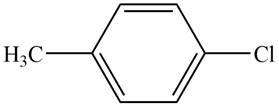
Figure 3
The parent ring is benzene. Chlorine atom is present on first carbon atom and methyl group is present on fourth carbon atom. The two substituents are across each other in benzene ring. The IUPAC name of the given compound is
The IUPAC name of the given compound is
(d)
Interpretation: The IUPAC name of the given compound is to be stated.
Concept introduction: IUPAC nomenclature is a systematic way of naming the organic compounds. The basic principles of IUPAC naming for benzene derivatives are:
1. The compound consists of benzene ring is named as substituent followed by benzene.
2. When the ring is mono-substituted, then there is no need of numbering.
3. When the ring is substituted with same substituents, then numbering to one substituent is given and for other substituent, numbering proceed from clockwise or anticlockwise such that it gets lower number.
4. When the ring is substituted with different substituents, then the numbering is done according to priority.
5. Substituents on benzene ring is also indicated using ortho, meta, para prefix. The prefix ortho is used when substituents are on adjacent carbon, meta is used when substituents are separated by one carbon atom, para is used when substituents are across each other in benzene ring.
Answer to Problem 17.28P
The IUPAC name of the given compound is
Explanation of Solution
The given compound is,
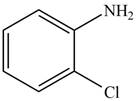
Figure 4
The parent ring is aniline. Chlorine atom and amine group are adjacent to each other in benzene ring. The IUPAC name of the given compound is
The IUPAC name of the given compound is
(e)
Interpretation: The IUPAC name of the given compound is to be stated.
Concept introduction: IUPAC nomenclature is a systematic way of naming the organic compounds. The basic principles of IUPAC naming for a benzene derivatives are:
1. The compound consists of benzene ring is named as substituent followed by benzene.
2. When the ring is mono-substituted, then there is no need of numbering.
3. When the ring is substituted with same substituents, then numbering to one substituent is given and for other substituent, numbering proceed from clockwise or anticlockwise such that it gets lower number.
4. When the ring is substituted with different substituents, then the numbering is done according to priority.
5. Substituents on benzene ring is also indicated using ortho, meta, para prefix. The prefix ortho is used when substituents are on adjacent carbon, meta is used when substituents are separated by one carbon atom, para is used when substituents are across each other in benzene ring.
Answer to Problem 17.28P
The IUPAC name of the given compound is
Explanation of Solution
The given compound is,
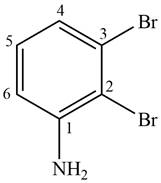
Figure 5
The parent ring is aniline. Two bromine atoms are present on second and third position. When same substituents are present then prefix depends on number of substituents are used. The IUPAC name of the given compound is
The IUPAC name of the given compound is
(f)
Interpretation: The IUPAC name of the given compound is to be stated.
Concept introduction: IUPAC nomenclature is a systematic way of naming the organic compounds. The basic principles of IUPAC naming for a benzene derivatives are:
1. The compound consists of benzene ring is named as substituent followed by benzene.
2. When the ring is mono-substituted, then there is no need of numbering.
3. When the ring is substituted with same substituents, then numbering to one substituent is given and for other substituent, numbering proceed from clockwise or anticlockwise such that it gets lower number.
4. When the ring is substituted with different substituents, then the numbering is done according to priority.
5. Substituents on benzene ring is also indicated using ortho, meta, para prefix. The prefix ortho is used when substituents are on adjacent carbon, meta is used when substituents are separated by one carbon atom, para is used when substituents are across each other in benzene ring.
Answer to Problem 17.28P
The IUPAC name of the given compound is
Explanation of Solution
The given compound is,
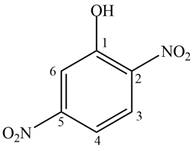
Figure 6
The parent ring is phenol. Two nitro groups are present on second and fifth position. When same substituents are present then prefix depends on number of substituents are used. The IUPAC name of the given compound is
The IUPAC name of the given compound is
(g)
Interpretation: The IUPAC name of the given compound is to be stated.
Concept introduction: IUPAC nomenclature is a systematic way of naming the organic compounds. The basic principles of IUPAC naming for a benzene derivatives are:
1. The compound consists of benzene ring is named as substituent followed by benzene.
2. When the ring is mono-substituted, then there is no need of numbering.
3. When the ring is substituted with same substituents, then numbering to one substituent is given and for other substituent, numbering proceed from clockwise or anticlockwise such that it gets lower number.
4. When the ring is substituted with different substituents, then the numbering is done according to priority.
5. Substituents on benzene ring is also indicated using ortho, meta, para prefix. The prefix ortho is used when substituents are on adjacent carbon, meta is used when substituents are separated by one carbon atom, para is used when substituents are across each other in benzene ring.
Answer to Problem 17.28P
The IUPAC name of the given compound is
Explanation of Solution
The given compound is,
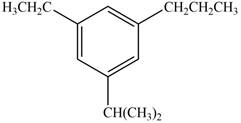
Figure 7
The parent ring is benzene. Ethyl group is present on second carbon atom, isopropyl group on third carbon atom and propyl group on fifth position. When same substituents are present then prefix depends on number of substituents are used. The IUPAC name of the given compound is
The IUPAC name of the given compound is
(h)
Interpretation: The IUPAC name of the given compound is to be stated.
Concept introduction: IUPAC nomenclature is a systematic way of naming the organic compounds. The basic principles of IUPAC naming for a cycloalkane are:
1. The cycloalkane is named after its parent hydrocarbon chain with a prefix cyclo.
2. When the ring is mono-substituted then there is no need of numbering.
3. When the ring is substituted with same substituents then numbering to one substituent is given and for other substituent numbering proceed from clockwise or anticlockwise such that it gets lower number.
4. When the ring is substituted with different substituents, then the numbering is done according to priority.
5. When alkyl chain has more carbon atoms than the cycloalkane then, the substituent is named as cycloalkyl group.
Answer to Problem 17.28P
The IUPAC name of the given compound is
Explanation of Solution
The given compound is,
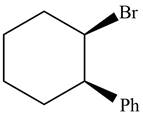
Figure 8
The number of carbon atoms in ring is six. Hence, its parent cycloalkane is cyclohexane.. Bromine atom is present on first carbon atom and phenyl group is present on second carbon atom. Both groups points in the same direction. The IUPAC name of the given compound is
The IUPAC name of the given compound is
Want to see more full solutions like this?
Chapter 17 Solutions
Organic Chemistry
- Indicate the product(s) B and C that are formed in the reaction: HN' OCH HC1 B + mayoritario C minoritario OCH3arrow_forwardIndicate the product(s) that are formed in the reaction: NH-NH, OCH3 -H₂O OCH3arrow_forward21.38 Arrange the molecules in each set in order of increasing acidity (from least acidic to most acidic). OH OH SH NH2 8 NH3 OH (b) OH OH OH (c) & & & CH3 NO2 21.39 Explain the trends in the acidity of phenol and the monofluoro derivatives of phenol. OH OH OH OH PK 10.0 PK 8.81 PK 9.28 PK 9.81arrow_forward
- identify which spectrum is for acetaminophen and which is for phenacetinarrow_forwardThe Concept of Aromaticity 21.15 State the number of 2p orbital electrons in each molecule or ion. (a) (b) (e) (f) (c) (d) (h) (i) DA (k) 21.16 Which of the molecules and ions given in Problem 21.15 are aromatic according to the Hückel criteria? Which, if planar, would be antiaromatic? 21.17 Which of the following structures are considered aromatic according to the Hückel criteria? ---0-0 (a) (b) (c) (d) (e) (h) H -H .8.0- 21.18 Which of the molecules and ions from Problem 21.17 have electrons donated by a heteroatom?arrow_forward1. Show the steps necessary to make 2-methyl-4-nonene using a Wittig reaction. Start with triphenylphosphine and an alkyl halide. After that you may use any other organic or inorganic reagents. 2. Write in the product of this reaction: CH3 CH₂ (C6H5)₂CuLi H₂O+arrow_forward
- 3. Name this compound properly, including stereochemistry. H₂C H3C CH3 OH 4. Show the step(s) necessary to transform the compound on the left into the acid on the right. Bri CH2 5. Write in the product of this LiAlH4 Br H₂C OHarrow_forwardWhat are the major products of the following reaction? Please provide a detailed explanation and a drawing to show how the reaction proceeds.arrow_forwardWhat are the major products of the following enolate alkylation reaction? Please include a detailed explanation as well as a drawing as to how the reaction proceeds.arrow_forward
- A block of zinc has an initial temperature of 94.2 degrees celcius and is immererd in 105 g of water at 21.90 degrees celcius. At thermal equilibrium, the final temperature is 25.20 degrees celcius. What is the mass of the zinc block? Cs(Zn) = 0.390 J/gxdegrees celcius Cs(H2O) = 4.18 J/gx degrees celcusarrow_forwardPotential Energy (kJ) 1. Consider these three reactions as the elementary steps in the mechanism for a chemical reaction. AH = -950 kJ AH = 575 kJ (i) Cl₂ (g) + Pt (s) 2C1 (g) + Pt (s) Ea = 1550 kJ (ii) Cl (g)+ CO (g) + Pt (s) → CICO (g) + Pt (s) (iii) Cl (g) + CICO (g) → Cl₂CO (g) Ea = 2240 kJ Ea = 2350 kJ AH = -825 kJ 2600 2400 2200 2000 1800 1600 1400 1200 1000 a. Draw the potential energy diagram for the reaction. Label the data points for clarity. The potential energy of the reactants is 600 kJ 800 600 400 200 0 -200- -400 -600- -800- Reaction Progressarrow_forwardCan u help me figure out the reaction mechanisms for these, idk where to even startarrow_forward
- Chemistry: Matter and ChangeChemistryISBN:9780078746376Author:Dinah Zike, Laurel Dingrando, Nicholas Hainen, Cheryl WistromPublisher:Glencoe/McGraw-Hill School Pub Co
 Organic ChemistryChemistryISBN:9781305580350Author:William H. Brown, Brent L. Iverson, Eric Anslyn, Christopher S. FootePublisher:Cengage Learning
Organic ChemistryChemistryISBN:9781305580350Author:William H. Brown, Brent L. Iverson, Eric Anslyn, Christopher S. FootePublisher:Cengage Learning Chemistry for Today: General, Organic, and Bioche...ChemistryISBN:9781305960060Author:Spencer L. Seager, Michael R. Slabaugh, Maren S. HansenPublisher:Cengage Learning
Chemistry for Today: General, Organic, and Bioche...ChemistryISBN:9781305960060Author:Spencer L. Seager, Michael R. Slabaugh, Maren S. HansenPublisher:Cengage Learning


